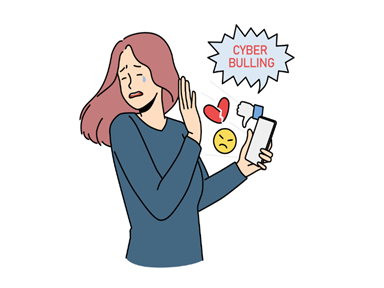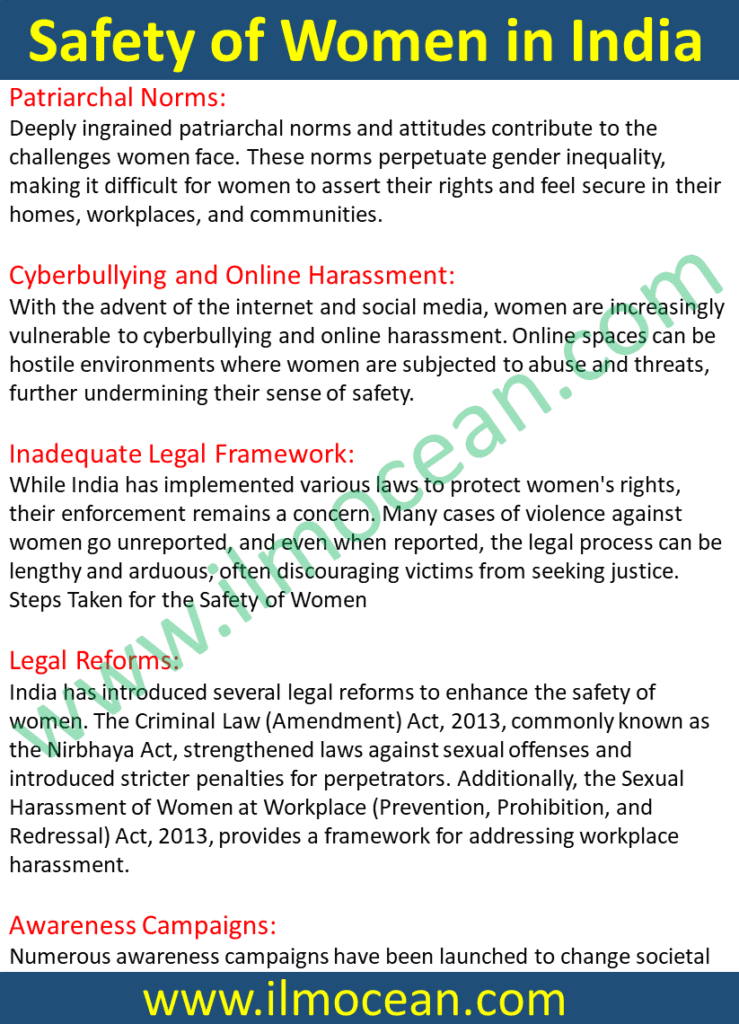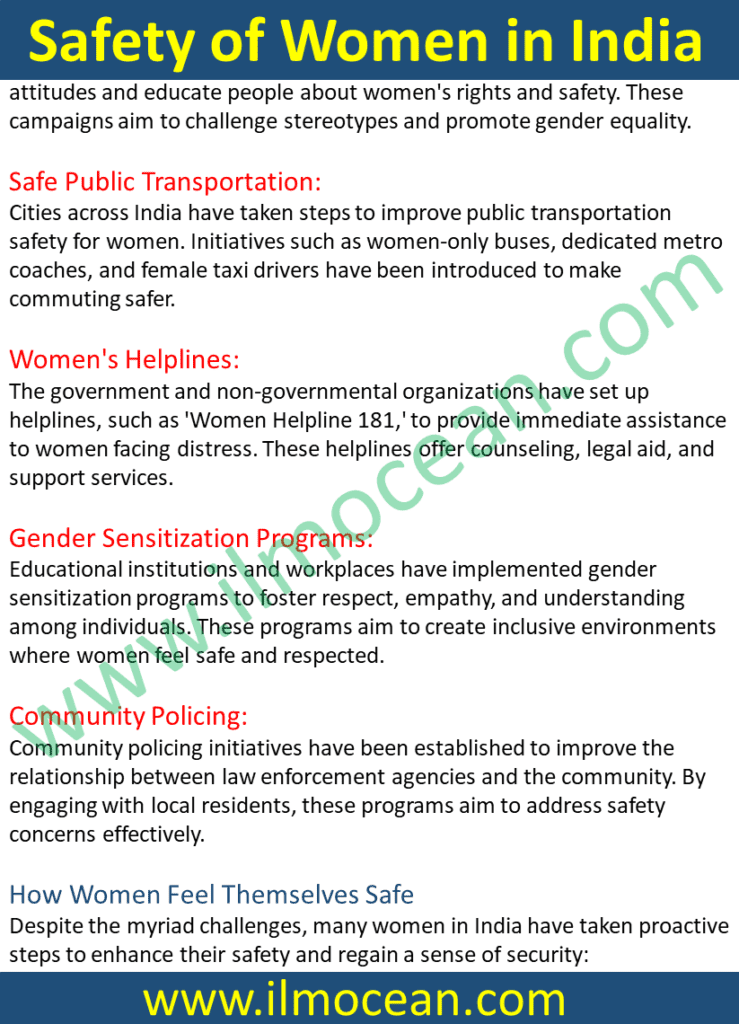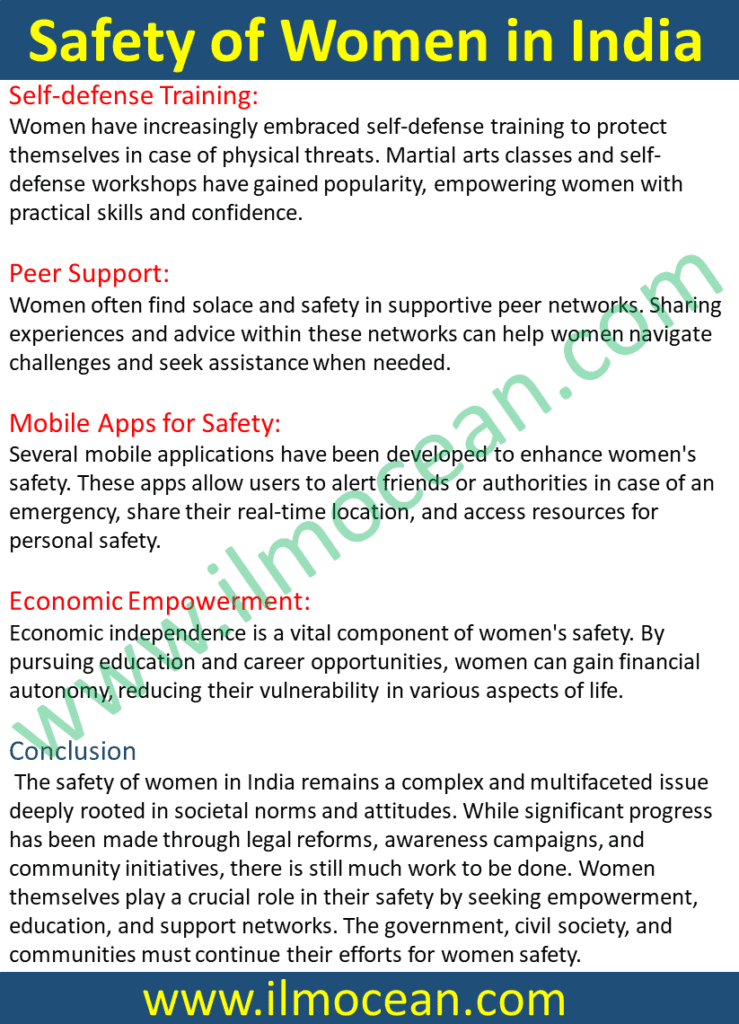In the vibrant tapestry of India’s cultural diversity and progress, the safety and security of women emerge as an issue that commands unwavering attention and immediate action. The fabric of our society is intricately woven with threads of tradition, modernity, and a rich history, yet women often find themselves navigating a challenging terrain fraught with concerns for their well-being. The safety of women in India extends far beyond the physical realm; it encompasses emotional, psychological, and social dimensions, each intricately linked to the other. In this era of enlightenment and progress, it is imperative that we address this issue head-on, striving for an environment where every woman feels not just secure but empowered, where safety is not just a privilege but an intrinsic right. As we embark on this journey, we must delve deep into the challenges women face, explore the progress made, and chart a course for a future where women can thrive without fear. This essay endeavors to shed light on the multifaceted issue of women’s safety in India and the collective steps we must take to ensure a brighter, safer future for all.
Introduction:
The safety of women in India has been a pressing concern for decades. While the country has made significant strides in various sectors, the safety and security of its female population remain a topic of intense scrutiny and debate. Women’s safety encompasses not only physical security but also emotional, psychological, and social well-being. This essay delves into the multifaceted issue of women’s safety in India, examining the challenges they face, the progress made, and the steps taken to ensure a safer environment for women.
Challenges Faced by Women in India:
Gender-Based Violence:
One of the most pervasive challenges women in India face is gender-based violence. This includes domestic violence, sexual harassment, rape, and acid attacks. According to statistics, a woman is raped in India every 15 minutes, highlighting the gravity of the situation. Such violence not only inflicts physical harm but also leaves deep emotional scars, affecting women’s sense of safety.
Lack of Safe Public Spaces:
Women often feel unsafe in public spaces due to inadequate lighting, poor infrastructure, and a lack of security measures. The fear of harassment or assault can deter women from participating in economic, social, and cultural activities outside their homes, limiting their opportunities and mobility.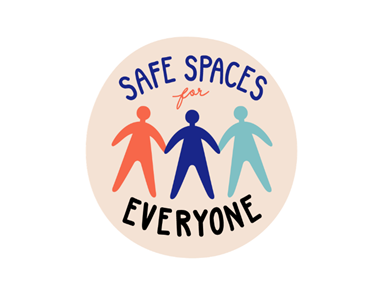
Patriarchal Norms:
Deeply ingrained patriarchal norms and attitudes contribute to the challenges women face. These norms perpetuate gender inequality, making it difficult for women to assert their rights and feel secure in their homes, workplaces, and communities.
Cyber bullying and Online Harassment:
With the advent of the internet and social media, women are increasingly vulnerable to cyberbullying and online harassment. Online spaces can be hostile environments where women are subjected to abuse and threats, further undermining their sense of safety.
Inadequate Legal Framework:
While India has implemented various laws to protect women’s rights, their enforcement remains a concern. Many cases of violence against women go unreported, and even when reported, the legal process can be lengthy and arduous, often discouraging victims from seeking justice.
Steps Taken for the Safety of Women
Legal Reforms:
India has introduced several legal reforms to enhance the safety of women. The Criminal Law (Amendment) Act, 2013, commonly known as the Nirbhaya Act, strengthened laws against sexual offenses and introduced stricter penalties for perpetrators. Additionally, the Sexual Harassment of Women at Workplace (Prevention, Prohibition, and Redressal) Act, 2013, provides a framework for addressing workplace harassment.
Awareness Campaigns:
Numerous awareness campaigns have been launched to change societal attitudes and educate people about women’s rights and safety. These campaigns aim to challenge stereotypes and promote gender equality.
Safe Public Transportation:
Cities across India have taken steps to improve public transportation safety for women. Initiatives such as women-only buses, dedicated metro coaches, and female taxi drivers have been introduced to make commuting safer.
Women’s Helplines:
The government and non-governmental organizations have set up helplines, such as ‘Women Helpline 181,’ to provide immediate assistance to women facing distress. These helplines offer counseling, legal aid, and support services.
Gender Sensitization Programs:
Educational institutions and workplaces have implemented gender sensitization programs to foster respect, empathy, and understanding among individuals. These programs aim to create inclusive environments where women feel safe and respected.
Community Policing:
Community policing initiatives have been established to improve the relationship between law enforcement agencies and the community. By engaging with local residents, these programs aim to address safety concerns effectively.
How Women Feel Themselves Safe?
Despite the myriad challenges, many women in India have taken proactive steps to enhance their safety and regain a sense of security:
Self-defense Training:
Women have increasingly embraced self-defense training to protect themselves in case of physical threats. Martial arts classes and self-defense workshops have gained popularity, empowering women with practical skills and confidence.
Peer Support:
Women often find solace and safety in supportive peer networks. Sharing experiences and advice within these networks can help women navigate challenges and seek assistance when needed.
Mobile Apps for Safety:
Several mobile applications have been developed to enhance women’s safety. These apps allow users to alert friends or authorities in case of an emergency, share their real-time location, and access resources for personal safety.
Economic Empowerment:
Economic independence is a vital component of women’s safety. By pursuing education and career opportunities, women can gain financial autonomy, reducing their vulnerability in various aspects of life.
Conclusion:
The safety of women in India remains a complex and multifaceted issue deeply rooted in societal norms and attitudes. While significant progress has been made through legal reforms, awareness campaigns, and community initiatives, there is still much work to be done. Women themselves play a crucial role in their safety by seeking empowerment, education, and support networks. The government, civil society, and communities must continue their collaborative efforts to create a safer and more equitable environment for women in India. Only through sustained commitment and a collective shift in attitudes can women truly feel safe and secure in all aspects of their lives.
You may also like to read:
Problems Faced by Women in India Essay
Role of Women in Society Essay
